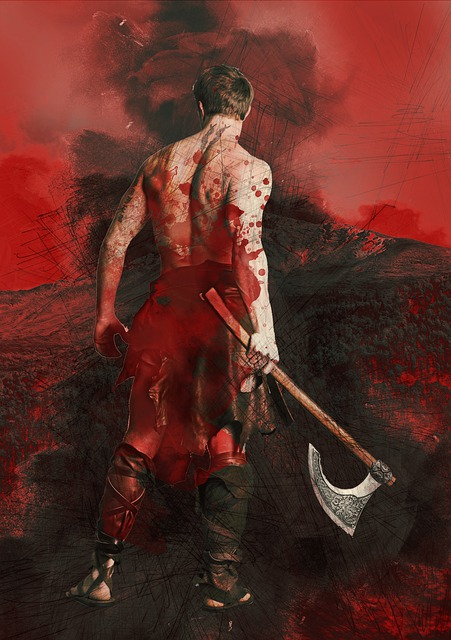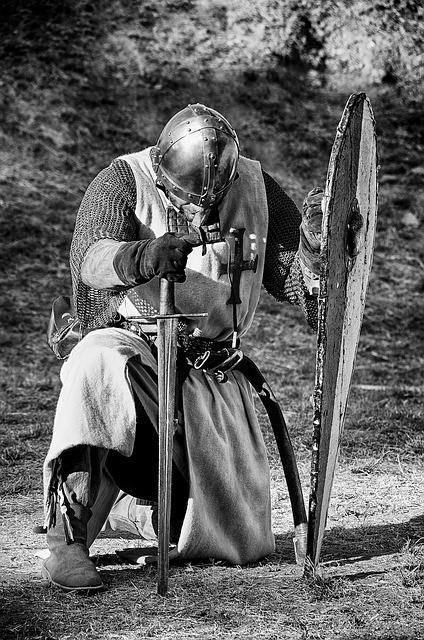The Viking age plays a significant role in British history. This period saw a lot of battles between the Norsemen and Anglo-Saxon England (AKA: The Vikings and West Saxons).
Vikings, originally from Scandinavian, voyaged throughout Europe raiding towns and villages and trading. Their way of life meant constant clashes with the locals wherever they landed. Even though the Viking forces were not a unit in most of their raids, their combat efficiency made them formidable opponents regardless of their numbers.
Several of the battles they fought were small-scale and focused on just pillaging.
However, there were times that the Viking warriors came together as the great Heathen army for wars that sought to claim lands and establish settlements. The battles between the Vikings and West Saxons went on for months and changed the landscape of many parts of Europe.
Their attempt to dominate the Anglo Saxons they met on the British isles is an example of such a period. They encountered strong resistance often and had to battle the kingdom several times.
This article will look at five major battles of the Viking Age and the impact these had on British history.
-
Battle of Stamford Bridge
First is the Battle of Stamford Bridge, one of the last wars fought between Anglo-Saxon England and the Viking army. Events before, during, and after the battle make it very relevant to British history.
Most notable among them is the last stand made by a lone Viking to hold back the English army so that the Viking forces could regroup and form a dense shield wall.
Legend says that this warrior cut down about 40 opponents in the process before he got stabbed in the back by an enemy soldier. His opponent had to do it through the floor of a bridge while he floated beneath it. This display of skill and bravery earned him the respect and admiration of both Norsemen (Vikings) and Englishmen (West Saxons).
Many historians consider the battle the final curtain of the Viking age, marking the end of their invasion of the British Isles.
Background
When Edward the Confessor passed away in 1066 AD, two people lay claim to the vacant English throne.
One was Harold Godwinson, who the English nobles had selected as the new ruler. The other was the then king of Norway, Harald Hardrada. He joined forces with Tostig Godwinson, the older brother of King Harold, rebelling against the crown after losing his nobility as Earl of Northumbria.
About 9,000 Viking warriors clashed with 12,000 English forces in this historic Anglo-Saxon chronicle.
Events of the Battle
Norse stories talk about how a rider had approached the invading Viking forces alone, asking Tostig to turn against Hardrada to regain his position as Earl in England.
The former refused this offer after he learned that his ally got nothing in the deal.
Hardrada, impressed with the courage of the rider who delivered the message, later discovered that it had been Harold Godwinson himself.
During the battle, the quick advance of the English army took the biking forces by surprise. They only slowed down at a narrow bridge which required a different formation. The brave Viking mentioned earlier took advantage of this change and held back enemy soldiers for several hours to allow his fellow Norsemen to re-strategize.
After both Hardrada and Tostig died in battle, the lines fell apart. Outflanked, outnumbered, and without a leader, the Viking army stood no chance in the battle.
Aftermath
The Norse suffered a heavy defeat at Stamford Bridge, losing over 8,000 men in the battle.
King Harold also lost a significant part of his army though the exact number is unclear. This weakened his defense of the kingdom some days later against the Normans led by William the conqueror. He died in that battle, leaving England at the mercy of its invaders.
-
Battle of Assandun
In 1016 AD, Cnut the Great formed the North Sea Empire after defeating Edmund Ironside at the battle of Assandun.
Historians consider this battle as the most definite emphasis on the Viking takeover.
The Norse king introduced a new royal lineage that ruled England for three generations till Edward the confessor took back the crown in 1040 AD.
Background
Aethelred the Unready ascended the English throne at age 12 and was forced into exile after a Viking king attacked him in response to the St. Brice day massacre. Cnut the Great, a descendant of this Norse king, would later make the rule official after the battle of Assandun.
The exiled Aethelred returned after some years in exile with his son, Edmund Ironside, to retake his throne. After he died in 1016 AD, Edmund and Cnut laid claim to the throne.
England split between which of the two men deserved to be king. Citizens of London elected Edmund as their king, while the nobles recognized Cnut instead.
War seemed like the only way to settle the dispute.
Events of the Battle
A few accurate sources cite an inspiring speech by Edmund Ironside to motivate his men before the battle. This inspired them to take an admirable stance against Cnut’s army.
Some believe the Anglo-Saxon forces might have even been victorious if Eadric Steona hadn’t betrayed Edmund and left the battlegrounds with his men. This allowed Cnut to penetrate the lines. After this, it was only a matter of time before the Viking army claimed victory.
Aftermath
The defeat forced Edmund into an agreement with Cnut, breaking England into two parts. He would still control Wessex and leave the rest of the country to the Norse king. If any of the two rulers died, the other would be king of the whole country. This is how Cnut took over England after Edmund passed away a year after the agreement.
Cnut’s lineage ruled England for three generations until Edward the Confessor, another son of King Aethelred, reclaimed the throne in 1040 AD. He restored the house of Wessex as the royals of the country.
-
Battle of Maldon
The Battle of Maldon in 991 AD was between Byrhtnoth and Viking raiders around Northey Island. It was a turning point in the relationship between the Norsemen and the nobles of England.
Many believe there was no need to engage the Viking forces who were not interested in occupying the land. Byrhtnoth’s prideful actions triggered a series of other events that lead to a total takeover of England by the great heathen army.
Background
Around the 10th century, the Viking invaders constantly attacked towns along the coast of England and a few other places in the British Isles to raid and plunder. The nobles were particularly concerned about this threat and for a long time held suspicions that the raiders might soon seek to rule the country.
There were several opinions on how to deal with the Viking forces to secure English lands and maintain noble positions.
Some agreed it was better to avoid conflict with the Norsemen, whose military prowess and thirst for battles seemed unmatched anywhere in Europe. As such, they would prefer paying off the Viking invaders any time they came to avoid bloodshed.
Other nobles felt too proud to give in to such arrangements with people they considered savages. They would rather fight back and die instead.
Byrhtnoth, an Ealdorman from Wessex, was convinced that the Viking warriors had to be met with force to prevent future attacks while maintaining his pride as a noble. On his own accord, he assembled an army to attack a raiding party led by a Viking warrior only known as Olaf.
Events of the Battle
English forces attacked the Vikings, who got stuck at a place believed to be Northey Island. Olaf demanded payment in fold and armor before he would agree to leave the as the Byrhtnoth wanted. The English noble replied that the only kind of payment they would give them would be the tips of their spear and sword blades.
Having the advantage, historians still don’t understand why Byrhtnoth allowed the larger Viking army to cross the stretch of water that had trapped them before attacking. Olaf and his men defeated the English and slew Byrhtnoth. He was decapitated but left with his golden hilted sword as a gesture.
Sources claim that the turning point during the battle was when the English soldiers saw a man named Godric fleeing on Byrhtnoth’s horse. They believed it was their leader and lost composure.
Aftermath
After the Battle of Maldon, Aethelred, then king of England, decided that paying the Norsemen to leave was a better option. He gave them plenty of silver and thus began the practice known as Danegeld.
Viking kings now offered this option to the leaders of the lands that they raided. The leaders had to choose this or suffer the consequences if they refused.
-
Battle of Edington
At the battle of Edington in 878 AD, Alfred the Great achieved one of the most famous Anglo-Saxon victories over the Vikings. It marked the beginning of a blend of the Norse and cultures affecting leadership styles, mint coins, and even religion.
Background
After the Great Heathen Army had conquered the Anglo-Saxon kingdoms of East Anglia and Northumbria, Wessex was the only one that remained after the Viking invasion.
King Alfred first tried to pay off the Norsemen, who took the money and refused to leave. Negotiations turned into a bloody battle that led to the defeat and exile of the English king.
He led a war against the Viking leader Guthram, the new ruler, as an outlaw hiding in the homes of peasants who had no idea of his true identity.
Events of the Battle
Alfred the Great succeeded in recruiting local men to his cause till he had rebuilt an army that was ready to take on the Vikings to restore the English crown. The ensuing battle took place outside the fortress of Chippenham, which was then under the control of the Danish army.
The Anglo-Saxon army used the shield wall tactics learned from previous Viking battles and pushed the Danish forces back into the fortress. After withstanding siege for 14 days, the Norsemen surrendered to the Anglo-Saxons due to starvation.
Knowing the impossible nature of trying to drive out the Danes from the other English kingdoms, Alfred allowed the enemy soldiers to return to their territories that were still under a Viking leader.
Aware of the Viking threat that still loomed, Alfred the Great used the opportunity to build border fortresses around his territories.
Aftermath
King Alfred managed to get Guthrum and his men to convert to Christianity after baptism in Somerset. The Viking king took the name Athelstan and was influential in introducing English culture to the many Danes.
Alfred’s wars also sparked military reforms in Anglo-Saxon warfare. These made future Viking raids very difficult and established the power balance between the Danish rulers and the kingdom of Wessex.
-
Battle of York
Ivar the Boneless and Ubbe led the largest Viking force the Anglo-Saxons faced in East Anglia. Known as the Great Heathen Army, they brutally conquered East Anglia.
The Battle of York in 867 AD against the Northumbrian army was a decisive victory in this famous march of the Vikings.
This Anglo-Saxon chronicle follows the adventures of Ragnar Lothbrok and his sons in the British Isles.
Background
Driven by his desire for revenge for his father’s death, Ivar and the Vikings docked east of the country and made their way towards York.
At that same time, Northumbria was experiencing civil war. Aella had overthrown King Osberht and thrown the kingdom into a battleground between the new king and the usurped.
This made it easy for the Vikings to capture the city when they attacked.
Events of the Battle
With the kingdom under threat from a more dangerous foe, Aella and Osberht marched together to York. The Vikings had already captured the city, and the two armies went to take it back.
They penetrated the outer city walls but faced a disadvantage within the narrow streets. The Vikings had more experience with this kind of battle and defeated the Northumbrian force.
Some records claim that King Aella and Osberht both died during the battle. However, other sources claim the former faced the Blood Eagle execution-style as satisfaction for Ivar’s thirst for revenge.
Only Wessex, under the rule of King Alfred, put up a challenge against the Vikings during this period.
Aftermath
Unlike earlier Viking raids, the goal for this Danish army was to take over England and settle there. The Kingdom of Jorvik was formed after the battle and became one of the earliest Viking settlements in Britain.
This kingdom prospered for years till it fell in 954 AD.
After its capture by the Anglo-Saxons, many Viking kings tried winning it back to no avail.
FAQs
Why Do the Battles Include Those That the Vikings Lost?
To the Vikings, the joy is in the battle itself, not whether they win or lose. In Norse mythology, the warrior who died on the battlefield would be welcomed into the halls of Valhalla by the god Oden to join others killed in combat.
Here they are promised a feast with liquor and Viking battles every day until Ragnorak.
What Is Ragnorak?
Vikings believed in the prophecy that the end of the world meant everything would be destroyed, including the gods. Ragnorak was an inevitable fate that they generally accepted.
The nine worlds and everything in them will be set ablaze during battles between the gods, giants, and the dead. They will sink into the sea and leave everything empty. There are some accounts of renewal after the destruction, but these are not accurate. Historians believe the Christian influence on the Vikings introduced that.
Did the Vikings Attack Only the British Isles?
Though England, Ireland, and Scotland had become major raid targets for the Vikings, Britain is not the only place the Danes attacked.
The Vikings went as far as Russia, the Middle East, and America. Their adventures in Canada and most of the Great Northern Peninsula are recorded in their tales of the Vinland.
They were seafaring men who only sought new lands to raid and plunder. Occasionally they established settlements in some lands but this wasn’t common. The thirst for adventure and war led the Danes to explore most of the world as we know it today.
Conclusion
Vikings fought other battles that deserve honorable mentions even though this article won’t explore them. Some of them are the battle of Englefield in 870 AD, Ashdown in 871 AD, Brunanburh in 937 AD, and the battle of Clontarf in 1014 AD. They also had some of their greatest conquests outside of Britain.
Medieval history portrays the Vikings as blood-thirsty savages who spread fear and chaos in their adventures. They were no different from most kingdoms during that period that went to wars to expand their territories and share their faith.
The significant thing about the Danes was that they did not fear dying in a battle. This made them formidable enemies to face.





